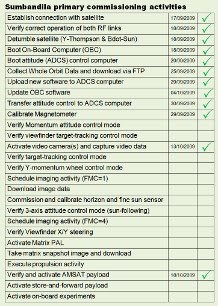Although a hugely successful mission thus far, the past six months have unfortunately not been without incident. We suffered a permanent loss of the Z-axis reaction wheel early on during commissioning, where after the ADCS algorithms have been adapted so as to still allow for controlled imaging with the remaining two wheels - Yaw-control was then slightly impeded and the off-Nadir Roll angle limited to ±20°.
Due to a power system anomaly, we have sadly lost access to one of the two CCD control boards. Each control board interfaces to one three-colour CCD. The board we lost contains the Green, Xantrophyl and Blue spectral bands, and the remaining board the Red, Red-Edge and Near-Infrared bands.
We have recently also lost the Y-axis reaction wheel (most likely also due to a power distribution failure), this meant the loss of three-axis control, but amazingly we can still take high-resolution images as before: the ADCS algorithms have been updated very innovatively whereby the satellite now “flies” in a derived Y-Thompson mode (the satellite tumbles “head-over-heals”). The spin rate in the Pitch axis is now 0.959°/s which results in an Forward Motion Compensation (FMC) rate of 4. This allows the imager to scan a target from back-to-front from the point where the satellite is pitched 15° forward over the target, to the point where it points 15° backwards. During the period that the image is scanned, the Roll angle is controlled by the remaining X-axis wheel, where the off-Nadir Roll angle is now limited to ±5°. The magtneto-torquers are used to phase the Pitch-rate such that the sub satellite point overlaps with the desired target at the center of the image.
We have obtained very good imaging results in this new control mode (see Miami and Dubai images in a separate post). The same controller is also used during data download sessions, but with a Pitch rate of 0.6°/s, and a Roll angle close to zero. During three download sessions last week on the same day, we managed to capture 6.3GB of image data via the S-band transmitter link, running at 72 Mbit/s!












